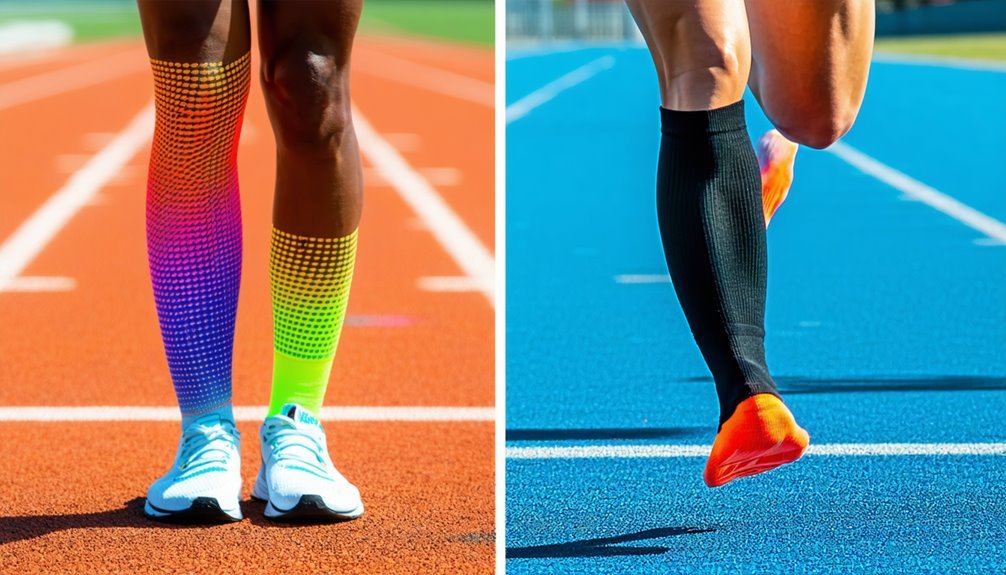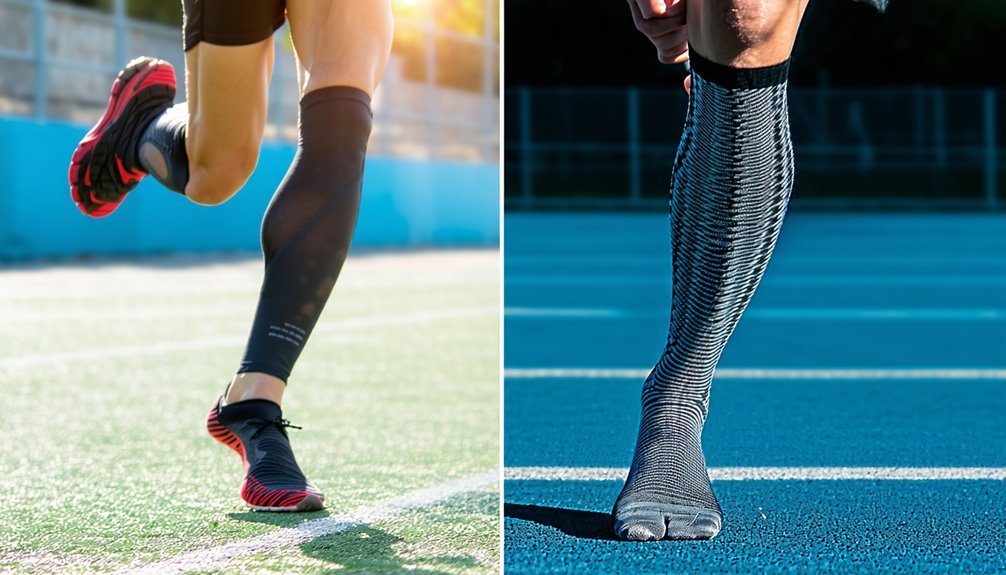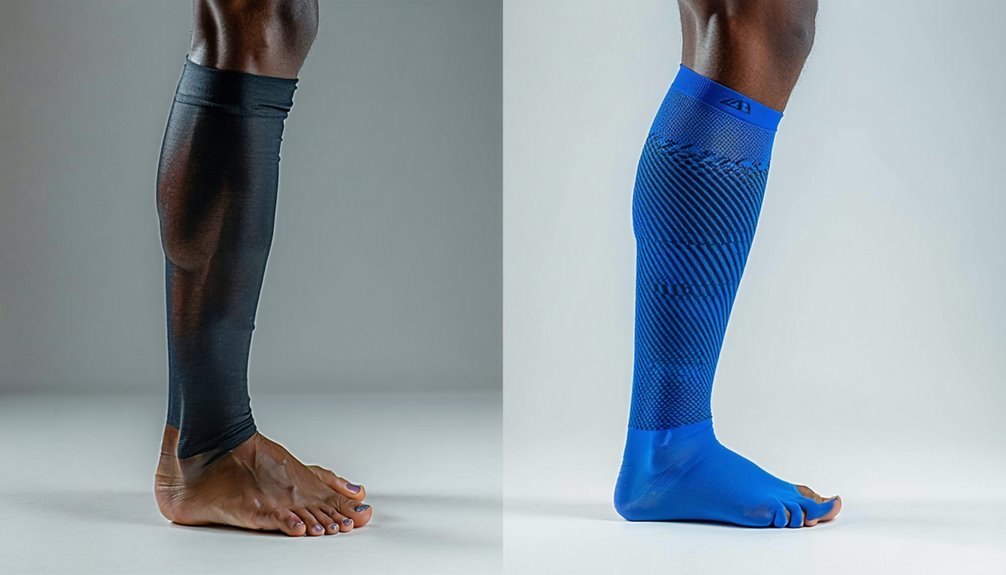Calf Sleeve Vs Compression Socks
When deciding between calf sleeves and compression socks, consider your specific needs. Calf sleeves provide targeted calf muscle support, ideal for athletes requiring ankle mobility. Compression socks offer full-foot to knee coverage, improving blood circulation and preventing lactic acid buildup, perfect for extended stationary situations or those prone to varicose veins. Both utilize breathable materials, but socks are typically more durable. Understanding these nuances will guide you in optimizing muscle support and recovery for your unique situation.
Understanding Calf Sleeves and Compression Socks

While both calf sleeves and compression socks are commonly used for enhancing circulation and muscle support, understanding their differences is vital for making an informed choice. Calf sleeves focus on providing targeted compression to the calf muscles, facilitating blood flow and reducing muscle fatigue. They're typically crafted from breathable, elastic materials that allow for flexibility. Consider calf sleeve materials like nylon or spandex to guarantee comfort and durability during physical activity. On the other hand, compression socks offer a full-foot fit, providing consistent pressure from the foot up to the knee. A proper compression sock fit is essential to prevent constriction, maximizing circulatory benefits. Prioritize precise measurements to avoid compromising safety and effectiveness when choosing either option for your needs.
Key Benefits of Calf Sleeves
When you're considering calf sleeves, it's essential to recognize their benefits, including enhanced muscle support, improved blood circulation, and reduced muscle fatigue. Evidence suggests that these sleeves apply graduated compression, which stabilizes your muscles and promotes venous return, helping to decrease the accumulation of lactic acid. This anatomical support not only mitigates fatigue but also aids in quicker recovery by ensuring ideal blood flow.
Enhanced Muscle Support
Although often overlooked, calf sleeves provide essential enhanced muscle support by stabilizing the calf muscles during physical activity. This stabilization reduces the risk of injuries, such as strains or tears, by minimizing excessive muscle vibration. By doing so, calf sleeves aid in muscle recovery and performance enhancement, allowing you to safely push your limits.
Anatomically, the compression exerted by calf sleeves supports the gastrocnemius and soleus muscles, maintaining their ideal alignment and function. Evidence suggests that this support reduces post-exercise soreness, facilitating quicker recovery. Moreover, by providing consistent pressure, calf sleeves help prevent overuse injuries, empowering you to engage in activities with confidence. Choosing a quality calf sleeve guarantees that your muscles are not only supported but also protected throughout your exercise regimen.
Improved Blood Circulation
In addition to enhanced muscle support, calf sleeves greatly improve blood circulation, which is a crucial aspect of athletic performance and recovery. By applying graduated compression, these sleeves promote efficient blood flow through the veins in your lower legs, facilitating the removal of metabolic waste products and delivering oxygen-rich blood to fatigued muscles. This process is essential for maintaining ideal vascular health and preventing issues like deep vein thrombosis, especially during prolonged periods of activity or sedentary behavior.
You'll find that this focused support can considerably enhance your endurance and reduce swelling. The snug fit of calf sleeves exerts gentle pressure on the superficial veins, encouraging blood to move upwards against gravity. This not only boosts circulation but also guarantees a safer, more effective workout experience.
Reduced Muscle Fatigue
Despite the rigors of intense physical activity, calf sleeves can considerably reduce muscle fatigue, thanks to their strategic compression design. By applying precise pressure to the calf area, these sleeves enhance muscle recovery and contribute to fatigue prevention. This compression stabilizes muscle oscillation and minimizes microtrauma during exercise, which is essential for maintaining muscle integrity. Scientifically, reduced oscillation means less muscle damage, facilitating quicker recovery and less soreness post-activity.
The graduated compression in calf sleeves promotes ideal blood flow, ensuring efficient oxygen delivery and waste removal from muscles. This physiological support aids in sustaining performance and delaying the onset of fatigue. If you're seeking to enhance muscle endurance while prioritizing safety, integrating calf sleeves into your routine can be a prudent choice for both amateurs and seasoned athletes.
Advantages of Compression Socks
When considering the benefits of compression socks, it's vital to understand how they enhance blood circulation and reduce swelling. By applying graduated pressure to the lower extremities, these socks promote venous return, effectively pushing blood back to your heart. This mechanism not only contributes to significant health benefits like reduced risk of deep vein thrombosis but also aids in performance enhancement. Improved circulation guarantees your muscles receive sufficient oxygen and nutrients, optimizing endurance and recovery.
Moreover, compression socks can prevent the buildup of lactic acid, which is important in minimizing muscle soreness and fatigue. Designed with anatomical precision, they fit snugly, providing comfort and support. By choosing the right compression level, you can safely enjoy their myriad advantages, fostering both short-term and long-term well-being.
Situations Where Calf Sleeves Shine
Why might you choose calf sleeves over compression socks? Calf sleeves offer specific advantages in enhancing athletic performance. They provide targeted compression to the calf muscles, which can help improve circulation and oxygen delivery during exercise. This anatomical precision supports muscle efficiency and endurance, essential for peak performance. Regarding recovery benefits, calf sleeves help reduce muscle soreness and expedite recovery by minimizing lactic acid buildup post-exercise. For injury prevention, their snug fit stabilizes the calf muscles, reducing the risk of strains or tears during high-intensity activities. Additionally, calf sleeves allow your feet to breathe freely, which can be particularly beneficial in sports requiring quick changes between different types of footwear. Prioritizing safety, calf sleeves help maintain ideal muscle health.
When to Opt for Compression Socks
Are there specific scenarios where compression socks outperform calf sleeves? Indeed, compression socks are ideal when full-leg circulation support is vital. They cover from foot to knee, promoting venous return, which can reduce the risk of deep vein thrombosis (DVT), particularly during long flights or extended periods of inactivity. The compression levels in these socks are significant; following usage guidelines guarantees peak safety and effectiveness. Compression socks provide consistent pressure, aiding in edema control and enhancing overall leg health. Their anatomical design targets the entire lower limb, making them suitable for individuals with varicose veins or those needing extensive support. When adhering to usage guidelines, compression socks can be an essential tool in maintaining circulatory health and preventing complications.
Making the Right Choice for Your Needs

When deciding between calf sleeves and compression socks, consider the benefits and limitations each option offers in relation to your specific activities and usage. Research indicates that calf sleeves may provide more targeted support for the lower leg muscles during exercise, while compression socks could enhance venous return and circulation throughout the entire leg. Additionally, evaluating the material and durability of each product is essential, as these factors influence comfort and longevity in your daily routine.
Benefits and Limitations
Although both calf sleeves and compression socks are designed to enhance circulation and support lower limb muscles, choosing the right option depends on your specific needs and activities. Calf sleeves can offer targeted compression to improve performance enhancement by promoting blood flow and reducing muscle vibration. This may contribute to injury prevention, especially during intense physical activity. However, they don't cover the feet, potentially limiting full lower limb support.
Compression socks, on the other hand, provide thorough coverage from the foot to the knee. This design guarantees more extensive venous return and can be beneficial for those who need full limb support, particularly during prolonged standing or post-exercise recovery. Consider your specific requirements, as well as any medical advice, to guarantee ideal safety and effectiveness.
Activity and Usage
Deciding between calf sleeves and compression socks hinges on the specific activities you engage in and your unique anatomical needs. If you're a runner or cyclist, calf sleeves may enhance calf sleeve performance by providing targeted support without covering your feet, allowing flexibility and breathability. They excel in activities where ankle mobility is vital. On the other hand, compression socks offer a full-length design beneficial for prolonged stationary activities or travel, as they guarantee a consistent compression sock fit, enhancing circulation from foot to knee. This holistic support can reduce the risk of deep vein thrombosis. Consider your activity level and any pre-existing conditions, such as varicose veins or swelling, to select the option that aligns with your performance and safety needs.
Material and Durability
Understanding the material composition and durability of calf sleeves and compression socks is essential for making an informed choice. Different fabric types offer varying levels of comfort and performance. Common materials include nylon, spandex, and polyester, each providing unique benefits. Nylon and spandex offer elasticity, while polyester enhances wear resistance. Your choice should align with your activity levels and longevity expectations. Consider the following comparison:
| Feature | Calf Sleeves | Compression Socks |
|---|---|---|
| Fabric Types | Nylon, Spandex | Nylon, Polyester |
| Wear Resistance | Moderate | High |
| Breathability | High | Moderate |
| Compression Level | Targeted | Full |
| Durability | Less than socks | Superior |
Opt for materials that guarantee safety and support, especially if you're prone to muscular fatigue or circulatory issues.
Frequently Asked Questions
Can Calf Sleeves and Compression Socks Be Worn Simultaneously?
Have you ever wondered if wearing calf sleeves and compression socks together provides double the benefit? For ideal fit, it's essential both offer proper calf support, ensuring no impaired circulation or excessive pressure, leading to safer, effective use.
How Do Calf Sleeves and Compression Socks Affect Skin Sensitivity?
You might experience skin irritation if pressure distribution from calf sleeves or compression socks isn't ideal. Guarantee proper fit and material choice to maintain skin health. Anatomically, even pressure helps prevent sensitivity and guarantees safety for sensitive skin.
Are Calf Sleeves or Compression Socks Better for Travel-Related Swelling?
For travel benefits and swelling prevention, compression socks are superior. They apply consistent pressure, supporting venous return and reducing edema. Anatomically, they cover the entire foot and calf, enhancing circulation, thereby ensuring safer, more comfortable travel.
What Materials Are Commonly Used in Calf Sleeves and Compression Socks?
When you're seeking the pinnacle of performance benefits, fabric types like nylon, spandex, and merino wool offer unparalleled support. These materials enhance circulation, reduce fatigue, and provide anatomical comfort, ensuring you stay safe and energized during any activity.
How Should Calf Sleeves and Compression Socks Be Washed and Maintained?
You should wash them in cold water using mild detergent, guaranteeing longevity. Avoid fabric softeners and bleach, as they degrade elasticity. Air-dry them flat to maintain compression efficacy. Regular maintenance guarantees anatomical support and prevents complications.







